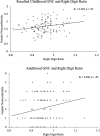Differences in digit ratios between gay men who prefer receptive versus insertive sex roles indicate a role for prenatal androgen
- PMID: 33854100
- PMCID: PMC8046970
- DOI: 10.1038/s41598-021-87338-0
Differences in digit ratios between gay men who prefer receptive versus insertive sex roles indicate a role for prenatal androgen
Abstract
Among non-human mammals, exposure to androgens during critical periods of development leads to gynephilia (attraction to females), whereas the absence or low levels of prenatal androgens leads to androphilia (attraction to males). However, in humans, retrospective markers of prenatal androgens have only been associated with gynephilia among women, but not with androphilia among men. Here, we asked whether an indirect indication of prenatal androgen exposure, 2D:4D, differs between subsets of gay men delineated by anal sex role (ASR). ASR was used as a proxy for subgroups because ASR groups tend to differ in other measures affected by brain sexual differentiation, such as gender conformity. First, we replicated the finding that gay men with a receptive ASR preference (bottoms) report greater gender nonconformity (GNC) compared to gay men with an insertive ASR preference (tops). We then found that Tops have a lower (male-typical) average right-hand digit ratio than Bottoms, and that among all gay men the right-hand 2D:4D correlated with GNC, indicating that a higher (female-typical) 2D:4D is associated with increased GNC. Differences were found between non-exclusive and exclusive same-sex attraction and GNC, and ASR group differences on digit ratios do not reach significance when all non-heterosexual men are included in the analyses, suggesting greater heterogeneity in the development of non-exclusive same-sex sexual orientations. Overall, results support a role for prenatal androgens, as approximated by digit ratios, in influencing the sexual orientation and GNC of a subset of gay men.
Conflict of interest statement
The authors declare no competing interests.
Figures



References
Publication types
MeSH terms
Substances
Grants and funding
LinkOut - more resources
Full Text Sources
Other Literature Sources

